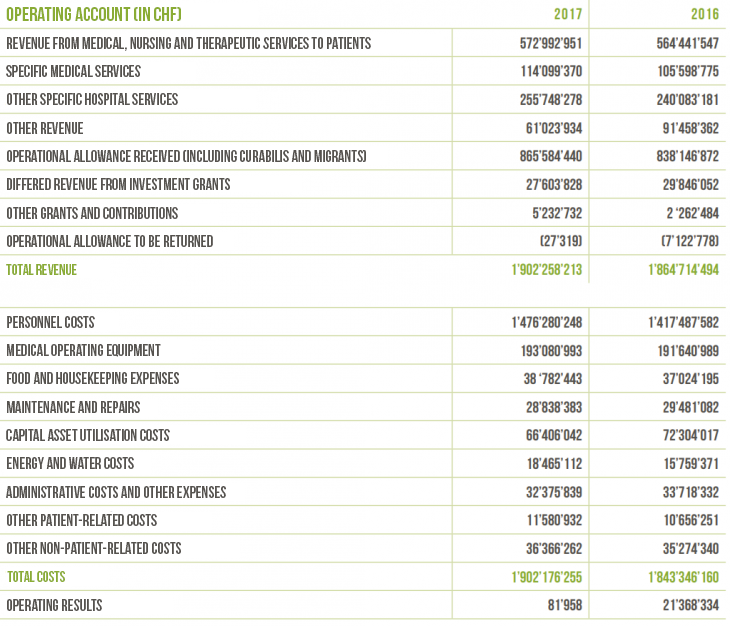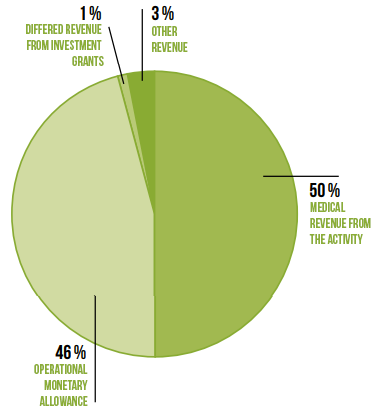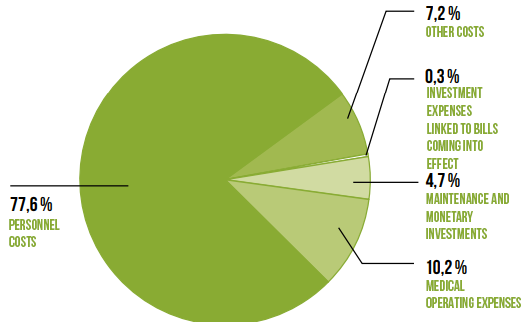- Service contract
- Change in revenue
- Change in expenditure
- Auditor’s report to the Board of directors on the 2016 summarised financial statements (FR)
HUG ends its 2017 financial year with balanced accounts. In a context of pressure on tariffs and savings demanded by the State, these balanced results illustrate HUG’s desire to stay on track while improving its processes and the quality of care. It is a question of meeting the needs of the Genevan population while responsibly managing resources.


Service contract
The service contract between HUG and the State of Geneva was renewed for a four-year period for the 2016-2019 period. It determines the financial resources engaged by the State along with the service provisions expected from HUG.
Provided by the State, the monetary allowance is made up of three budgets: the largest is for operations, another for research and teaching, and the third for activities in the public interest.
In 2017, the State provided 865.6 million Swiss francs for operations and 32.8 for investment.
Change in revenue
In 2017, the total revenue saw a 2% increase compared to 2016:
- + 2.9% for hospital services
- + 5.8% for outpatient care.
This change reflects the rise in activity in the DRG zone and the complexity of the cases handled.
In the outpatient zone, rebilling of laboratory services rose due to the use of new high added value techniques, such as:
- molecular biology following the introduction of tumour boards in oncology and
- histocompatibility tests in view of a graft.
Between 2013 and 2017, HUG’s medical revenue increased by 23%. Over the same five-year period, the monetary operating allowances provided by the State have increased by 5%.
53% of revenue
is medical revenue or other revenue
1,21
is the average cost weight*
for stays in 2017. It is identical to 2016.
* This average cost weight takes into account the complexity of hospitalisation cases handled in the DRG billing zone
Change in expenditure
In 2017, personnel costs increased by 4.1% compared to 2016. This rise is particularly explained by:
- complete integration of the Joli-Mont and Crans-Montana Clinics
- salary mechanisms (payment of an annuity, increase in the pension contribution rate).
Other operating expenses represent 25.5% of the total expenses and remain stable overall compared to 2016’s accounts (+0.1%).
Over a five-year period (2013-2017), personnel costs have risen by 14.3%. This rise is largely due to:
- the integration of the Joli-Mont and Crans-Montana Clinics
- the granting of new mandates such as Curabilis
- the operational opening of the Gustave Julliard building and the Maternity hospital extension.
3/4 of HUG's expenses
are represented by personnel costs
Over the same period, costs linked to medical operating equipment have risen by 13.7% since 2013, linked to:
- more frequent use of cutting-edge technologies
- increasingly complex diseases
- the rise in drug costs.
Nonetheless, their rise has diminished over the past two years due to the efforts made by HUG to optimize its purchases. Finally, other costs such as food, housekeeping, maintenance and repairs, capital asset utilisation costs, energy and water, financial, administrative and IT costs, other patient-related or non-patient-related costs, are effectively controlled. Since 2013, they have fallen by 1.8% (4.3 M CHF) despite a rise in activity and the operational opening of two new buildings.